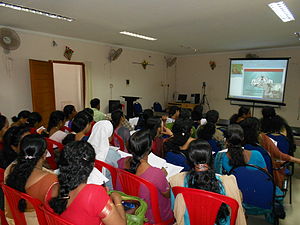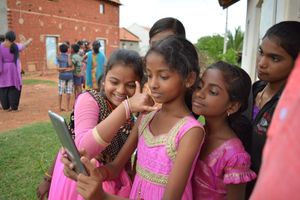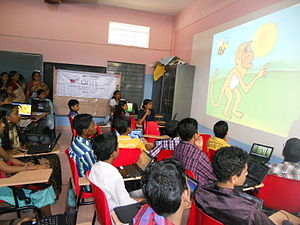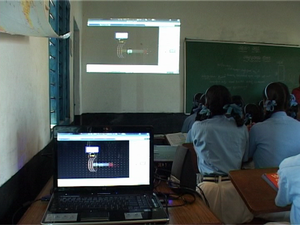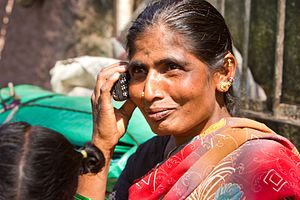Difference between revisions of "ICT student textbook/What is the nature of ICT"
| Line 46: | Line 46: | ||
You can also make your portfolio such that you can keep adding to it. How is that possible? When you make a model of clay or thermocoal, you cannot change it after you make it. One of the special features of ICT is that you can change (edit) your creation. This means that, in Class 7 you can change what you completed in class 6 or in Class 8 you can change what you completed in class 7. This means you can keep adding to your knowledge and also improve the quality of your output. You will have a cumulative portfolio at the end of class 8. | You can also make your portfolio such that you can keep adding to it. How is that possible? When you make a model of clay or thermocoal, you cannot change it after you make it. One of the special features of ICT is that you can change (edit) your creation. This means that, in Class 7 you can change what you completed in class 6 or in Class 8 you can change what you completed in class 7. This means you can keep adding to your knowledge and also improve the quality of your output. You will have a cumulative portfolio at the end of class 8. | ||
| − | ==== | + | ====[[ICT student textbook/What is the nature of ICT level 1|What is the nature of ICT level 1]]==== |
| − | [[ICT student textbook/What is the nature of ICT level 1]] | ||
| − | [[ICT student textbook/What is the nature of ICT level 2]] | + | ====[[ICT student textbook/What is the nature of ICT level 2| What is the nature of ICT level 2]]==== |
| − | [[ICT student textbook/What is the nature of ICT level 3]] | + | ====[[ICT student textbook/What is the nature of ICT level 3|What is the nature of ICT level 3]]==== |
The detailed description of objectives for each level are discussed [[ICT_student_textbook/What_is_the nature_of_ICT_level_1|here]]. | The detailed description of objectives for each level are discussed [[ICT_student_textbook/What_is_the nature_of_ICT_level_1|here]]. | ||
Revision as of 14:12, 18 November 2016
What is this unit about
We saw in the previous chapter about how ICT are part of many things we do; and how they have changed the way we are working, learning and even playing. What is it about ICT that allow such changes to happen is what we will look at in this unit.
Let us consider the following pictures:
Image credits: Kerala IT@Schools project, Government high school science class, Mysuru, IT for Change, Wikimedia Commons. All images are licensed under Creative Commons license which allows for free sharing with attribution.
Look at these pictures and make a list of words that come into your mind when you see the pictures. Also describe what you see in the setting. What did you come up with? Discuss these with your friends and teachers.<br>
That is correct! ICT can help you:
- Create your own drawings
- Talk to people - through audio or video
- Make videos
- Access information in different ways
- Is there any more you can think of?
To do these things, you use ICT devices including a mobile phone, a computer, camera and many more.
Ask your teacher or parent or other older members in your neighbourhood when was the first time they saw a computer or a phone or TV. People may tell you about how they communicated or did things in the days before the phone. It may be very hard for you to imagine but ICT (and all other technologies) were not always there - they got developed over time.
In this unit, you will learn about what is the nature of ICT, how ICT developed and how we need to work with ICT for all of us to benefit. You can read more about how ICT developed in the chapter on Science, Technology and Society.
Objectives
- Understanding the nature of ICT - how technology has developed in society, how ICT has developed and how it has changed the way society is organized today
- Understanding how to use technology for self learning and connecting with each other for learning
- Understanding about the ICT environment - various devices and applications
- Understanding that you can do various things with ICT (like writing, painting, mapping, singing)
- Understanding the safe use of ICT
- Understanding the ethical and legal aspects of ICT
How is the unit organized
In this unit, there are three levels of activities, to match roughly to classes 6-8. The activities will increase in difficulty - based on the ICT skills needed as well as subject knowledge that you will be building. As you work on the various activities for the different ICT areas in the each level, you will also get experienced with more ICT skills and this would help you with the subsequent level.
You can imagine this somewhat like a spiral staircase where you learn some topic at a basic level, you move along to the next class and you can come back to discuss the same topic at a more advanced level.
At each level you will be exploring new things about ICT; you will also be creating your outputs and building what is called a digital portfolio. This portfolio will include your outputs; they will be such that you will know what you have learnt and you will also know the method of learning. At the end of the year, your teacher will assess your portfolio.
You can also make your portfolio such that you can keep adding to it. How is that possible? When you make a model of clay or thermocoal, you cannot change it after you make it. One of the special features of ICT is that you can change (edit) your creation. This means that, in Class 7 you can change what you completed in class 6 or in Class 8 you can change what you completed in class 7. This means you can keep adding to your knowledge and also improve the quality of your output. You will have a cumulative portfolio at the end of class 8.
What is the nature of ICT level 1
What is the nature of ICT level 2
What is the nature of ICT level 3
The detailed description of objectives for each level are discussed here.
| Level | Objectives | Digital Literacy Component | Looking at your learning |
| Level 1 |
|
|
|
| Level 2 |
|
|
|
| Level 3 |
|
|
|
